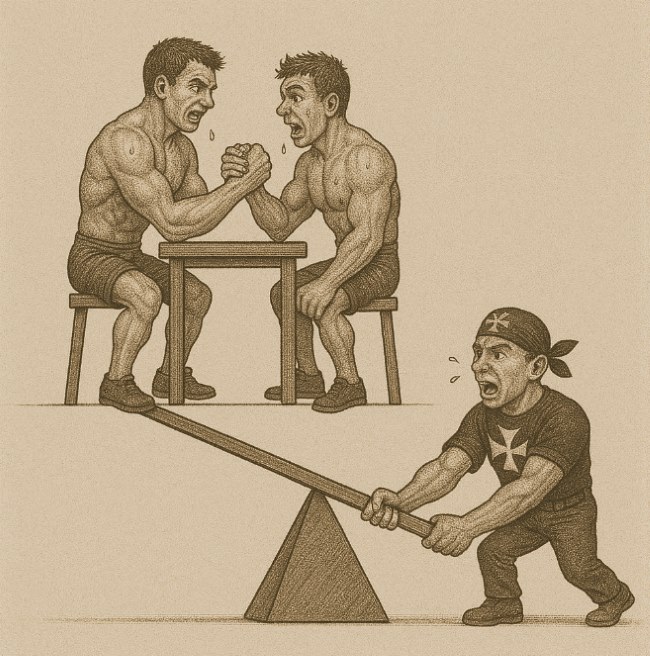| Malta Short Let: Cozy Stay in Gzira | |
|
Sliema Area Modern Designer Finished 2 Bedrooms + Games Room. First floor with Maltese Balcony Large back Terrace with swinging sofa Fully Airconditioned + Full Kitchen 3 TVs, including 65” with backlight. |
 |
|
Book Now: Google Travel | Direct (Cheapest) | Booking.com | Airbnb |
|
A Maltese Mental Model by Edward de Bono
A small coffee shop, is sitting between two giants—Starbucks on one side, Costa on the other. The owner could compete on price (and lose). She could compete on quality (and struggle). Or she could do something radical: stop competing altogether.
Located on the border between Gzira and Sliema—an area already saturated with excellent coffee—she knows competing on coffee quality alone would be futile. Instead, she transforms her shop into something Malta has never seen: a “connection café.” No phones or laptops allowed. Large communal tables replace small, isolating ones. Flash cards with conversation starters sit in wooden boxes—people can pick a card to break the ice or simply pass.
What emerges surprises even her. The community begins organizing chess tournaments and debate nights. Strangers become friends. Most ingeniously, she installs a simple lighting system at each table: green for “all good,” orange for “getting tense,” and red for “time out”—allowing groups to self-regulate when conversations grow too heated. Though mostly, the lights stay green. People, it turns out, have been managing conversations for millennia; technology had just made them forget how.
Her clientele transforms completely. Instead of competing for hurried commuters grabbing their morning fix, she attracts people seeking what technology had taken away: genuine human connection. While Starbucks sells coffee, she sells conversation. While Costa offers WiFi, she offers community. She isn’t in the coffee business anymore—she’s in the connection business.
This hypothetical example perfectly illustrates sur/petition in action—Edward de Bono’s revolutionary concept that’s more relevant than ever in our hyper-competitive, AI-disrupted world.
A Note on Framing: While Edward de Bono never explicitly called sur/petition a “Maltese Mental Model,” this article uses that interpretive lens to connect his concept to Malta’s historical reality. Unable to compete on size, population, or natural resources, Malta has consistently survived and thrived by creating unique value—as a strategic fortress, a shipping hub, a tourist destination, and a financial center. This national strategy mirrors the sur/petition mindset: don’t fight the giants on their terms; create a new game you are uniquely suited to win.
Disclaimer: This article provides an educational summary and modern application of the sur/petition concept developed by the late Dr. Edward de Bono. The term “sur/petition” and its framework are his intellectual property. This article is intended for commentary and educational purposes. By analyzing and applying Dr. de Bono’s framework to modern examples, we aim to encourage readers to engage with and purchase the original source material for a complete understanding. For the definitive explanation, we strongly encourage readers to purchase Dr. de Bono’s book, Sur/petition: Creating Value Monopolies When Everyone Else is Merely Competing.
🎭 Competition vs. Sur/petition: The Fundamental Shift
| Competition Mindset | Sur/petition Mindset | Result |
|---|---|---|
| How can we be better? | How can we be different? | Unique value proposition |
| Benchmark against rivals | Create new benchmarks | Category leadership |
| Fight for market share | Create new markets | Value monopoly |
| Driven by what customers compare | Driven by what customers secretly crave | Premium pricing power |
| Win-lose dynamics | Create-value dynamics | Expanded possibilities |
🔑 Key Insight: Sur/petition isn’t about being uncompetitive or avoiding competition. It’s about competing in dimensions others haven’t imagined. While they fight over existing value, you create new value.
🧩 Key Approaches to Sur/petition
We can understand sur/petition through these key approaches derived from de Bono’s work:
Approach 1: Integrated Values
Don’t just sell a product—integrate multiple values that work together. This mirrors Malta’s own strategy—integrating its strategic location, multilingual workforce, and EU membership to create a unique value proposition for international business that is more than the sum of its parts:
Approach 2: Serious Creativity
Use Lateral Thinking to create value in unexpected places:
- Competition: Restaurants compete on food quality and ambiance
- Creative Insight: What if diners cooked their own food?
- Sur/petition: Korean BBQ and hot pot restaurants don’t compete with traditional restaurants—they offer participation value
- New Value: Entertainment + dining + social experience
Approach 3: Concept Extraction
Extract the core value and deliver it in new ways:
| Traditional Business | Core Concept | Sur/petition Innovation |
|---|---|---|
| Bookstore | Access to knowledge | Kindle: Instant access to millions of books |
| Video rental | Home entertainment choice | Netflix: Unlimited streaming |
| Taxi service | Point-to-point transport | Uber: Transport on demand |
| Hotels | Temporary accommodation | Airbnb: Live like a local |
Approach 4: Value Monopolies
Create value so unique that comparison becomes impossible—a core de Bono concept:
- Identify unmet values: What do people want but can’t get?
- Combine unusual elements: Mix values that don’t normally go together
- Lock in uniqueness: Make it hard for others to copy
- Build switching costs: Create value that grows with use
Approach 5: Getting There First
Not just being first to market, but first to recognize new value spaces:
⚠️ Important Distinction: Being first isn’t about speed—it’s about perception. The first to see that customers wanted “experiences” not just “products” created entire industries. Use Water Logic to spot where value is flowing before others notice.
Approach 6: Valufacture
This is what de Bono calls “valufacture”—his term for the deliberate manufacturing of value rather than just products:
De Bono’s Definition: “Valufacture is the deliberate process of creating values. Just as manufacture is the production of things, valufacture is the production of values. In sur/petition, we don’t just make better products—we create new forms of value that didn’t exist before.”
🏆 Sur/petition Success Stories
Case 1: Local Accounting Firm – From Hourly to Peace of Mind
Traditional Competition: Local accountants competed on hourly rates and response times
Sur/petition Strategy:
- Stopped billing by the hour entirely
- Created “Financial Peace of Mind” flat-fee subscription
- Bundled bookkeeping, tax prep, and monthly strategy calls
- Positioned against “anxiety” not other accountants
Result: Tripled revenue with half the clients, waiting list for new subscribers
Sur/petition Principle Applied: Created a value monopoly by integrating multiple services into a unique offering that transcends traditional accounting competition.
Case 2: Cirque du Soleil – Redefining the Circus
Traditional Competition: Circuses competed with bigger acts, more animals, famous performers
Sur/petition Strategy:
- Eliminated animals (removed cost and controversy)
- Combined circus with theater and dance
- Targeted adults, not children
- Created artistic narratives, not just acts
Result: Created a new category worth billions, with ticket prices 10x traditional circuses
Sur/petition Principle Applied: Through concept extraction and valufacture, they created an entirely new form of entertainment. While this example is also famously used in Blue Ocean Strategy literature, it perfectly illustrates de Bono’s principle of creating value monopolies where direct comparison becomes impossible.
Case 3: Dollar Shave Club – Simplicity as Sur/petition
Traditional Competition: Razor companies competed on blade technology and features
Sur/petition Strategy:
- Focused on convenience over technology
- Created subscription model for commodity product
- Built community through humor and values
- Made “good enough” razors with exceptional delivery
Result: Sold to Unilever for $1 billion after just 5 years
Sur/petition Principle Applied: By extracting the core concept (regular access to razors) and integrating new values (convenience, community), they created a value space Gillette couldn’t compete in without cannibalizing their high-margin business.
Case 4: B2B Software – From SaaS to Results
Traditional Competition: Project management software competed on features and integrations
Sur/petition Strategy:
- Stopped selling software licenses
- Offered “Done For You” service using their own software
- Created new category between SaaS and full-service agency
- Charged for outcomes, not tools
Result: 10x average customer value, 90% retention rate
Sur/petition Principle Applied: Valufacture in action—manufacturing value (completed projects) rather than just tools. This creates a value monopoly competitors can’t match without fundamental business model changes.
❗ The Hard Realities of Sur/petition
Sur/petition isn’t a magic bullet. Here are the challenges rarely discussed:
The Risk of Misfire
Creating a new value space is inherently risky because the market may not exist yet. For every Cirque du Soleil, there are dozens of failed concepts that misjudged what customers would actually pay for. The “build it and they will come” fallacy is real.
The First Mover Disadvantage
The pioneer often educates the market at great expense, only for a “fast follower” to come in and dominate once the value is proven. Myspace created social networking; Facebook perfected it. Being first to imagine new value doesn’t guarantee capturing it.
Internal Resistance
Radical sur/petition ideas are often killed by internal departments focused on optimizing the current business model. The “corporate immune system” attacks anything that threatens existing revenue streams, metrics, or power structures.
🛠️ The Sur/petition Toolkit
Tool 1: The Value Audit (Connected to de Bono’s CAF)
Map what values you’re currently delivering vs. what’s possible, using de Bono’s Consider All Factors approach:
| Current Values | Hidden Values | Potential New Values |
|---|---|---|
| What customers pay for | What they enjoy but don’t pay for | What they can’t get anywhere |
| Example: Coffee quality | Example: WiFi, ambiance | Example: Guaranteed silence |
Tool 2: The Competition Escape Matrix (Using de Bono’s Thinking Tools)
For each competitive dimension, find the escape route using de Bono’s established tools:
| They Compete On… | You Could Instead… | Using This de Bono Tool… |
|---|---|---|
| Price | Create value bundles | PMI to evaluate bundles |
| Features | Simplify radically | Simplicity principles |
| Speed | Change the timeline | C&S thinking |
| Quality | Redefine quality | Lateral Thinking |
Tool 3: Value Innovation Canvas (A Sur/petition Application)
- What does everyone take for granted?
- What rules does everyone follow?
- What values are considered essential?
Step 2: Challenge Each Assumption (Using de Bono’s PO)
- Use PO: “Cars must have drivers”
- Apply APC: What alternatives exist?
- Consider opposites: What if we did the reverse?
Step 3: Design New Value Combinations
- Mix values from different industries
- Eliminate assumed necessities
- Add unexpected elements
Step 4: Test Value Uniqueness
- Can competitors easily copy this?
- Does it create new customer behaviors?
- Does comparison become difficult?
🎯 Sur/petition in Practice: A Step-by-Step Guide
Pre-Step: Understand Your Current Competitive Landscape
- ✓ Map all current competitors and their value propositions
- ✓ Identify the “rules” everyone follows
- ✓ Understand why customers choose between options
- ✓ Recognize the metrics driving the industry
- ✓ Use Six Thinking Hats for comprehensive analysis
Phase 1: Recognize the Competition Trap
- ✓ Constantly comparing features with competitors
- ✓ Racing to match competitor moves
- ✓ Shrinking margins despite “improvements”
- ✓ Customers see you as interchangeable
- ✓ Innovation means incremental improvements
Phase 2: Identify Value Opportunities
Use this question framework:
- What annoys customers about the entire industry?
- What do non-customers say about why they don’t buy?
- What adjacent values could we integrate?
- What would this look like in a completely different industry?
Phase 3: Create Value Combinations
| Traditional Value | + Unexpected Value | = Sur/petition |
|---|---|---|
| Fitness training | Entertainment | Peloton (home fitness entertainment) |
| Accommodation | Local experience | Airbnb (live like a local) |
| Transportation | Productivity space | Waymo (office on wheels) |
| Shopping | Discovery algorithm | Stitch Fix (AI stylist) |
Phase 4: Build Value Moats
✅ Making Sur/petition Sustainable:
- Network Effects: Value increases with more users
- Data Advantages: Unique insights competitors can’t access
- Ecosystem Lock-in: Multiple integrated values
- Cultural Identity: Becoming part of customer identity
- Continuous Innovation: Stay ahead of copycats
⚠️ Common Sur/petition Mistakes
| The Mistake | Why It Fails | How to Avoid |
|---|---|---|
| Fake Differentiation | Adding gimmicks instead of real value | Focus on customer jobs-to-be-done |
| Complexity Addition | More features ≠ more value | Use Simplicity principles |
| Ignoring Core Value | Losing sight of why customers buy | Maintain essential value while adding new |
| Premium for Premium’s Sake | Higher price without clear new value | Price should reflect unique value |
| One-Hit Wonder | Single innovation without follow-through | Build continuous innovation culture |
🔗 Sur/petition Amplifies Other de Bono Tools
Sur/petition works best when combined with other de Bono tools:
| Tool Combination | How They Work Together |
|---|---|
| Lateral Thinking + Sur/petition | Generate radical value innovations through pattern breaking |
| Six Hats + Sur/petition | Yellow Hat finds value opportunities; Green Hat creates combinations |
| Water Logic + Sur/petition | Map how value flows to find new channels |
| PO + Sur/petition | Challenge industry assumptions to find escape routes |
| Simplicity + Sur/petition | Create elegantly simple new value propositions |
🤖 Sur/petition in the AI Age
AI makes sur/petition both more necessary and more possible:
Why Sur/petition Matters More with AI:
1. AI Accelerates Competition: Algorithms can optimize traditional competition faster than humans. The only escape is creating new games.
2. AI Enables Hyper-Personalization: Use AI to create value combinations impossible before—mass customization at scale.
3. AI Reveals Hidden Values: Machine learning can identify value patterns humans miss, opening new sur/petition opportunities.
4. AI as Sur/petition Tool: Don’t compete with AI—use it to create value others can’t imagine. Traditional AI in fashion retail competes by optimizing inventory. Sur/petition AI, like Stitch Fix, uses AI to create an entirely new value proposition: “a personal stylist for everyone,” shifting the game from “shopping” to “discovery and styling.”
| Traditional AI Use | Sur/petition AI Use |
|---|---|
| Optimize existing processes | Discover new value combinations |
| Compete on efficiency | Create new customer experiences |
| Predict competitor moves | Predict unexplored value spaces |
| Automate current business | Enable impossible businesses |
🎬 Your Sur/petition Action Plan
Week 1: Competition Audit
- □ List all the ways you currently compete
- □ Identify which competitions you’re losing or struggling with
- □ Note where margins are shrinking despite efforts
- □ Use CAF to ensure comprehensive analysis
Week 2: Value Discovery
- □ Interview customers about unmet needs
- □ Study non-customers—why don’t they buy?
- □ Map adjacent industries for value inspiration
- □ Apply OPV to understand all perspectives
Week 3: Creative Combinations
- □ Use Lateral Thinking to generate wild combinations
- □ Apply PO to challenge every assumption
- □ Create at least 10 sur/petition concepts
- □ Test each with PMI analysis
Week 4: Value Testing
- □ Build minimal value prototypes
- □ Test with friendly customers
- □ Refine based on excitement levels
- □ Use C&S to project long-term impact
🌍 Sur/petition: The Maltese Connection
Malta’s entire economic strategy exemplifies sur/petition principles at a national level:
Malta’s Sur/petition Success Story
The Challenge: Small island nation with limited natural resources, surrounded by larger economies.
Traditional Competition Would Mean: Trying to match Italy’s manufacturing, compete with Sicily’s agriculture, or rival North Africa’s low costs.
Malta’s Sur/petition Strategy:
- Financial Services: Not competing with London or Frankfurt on size, but creating unique value through EU membership + English language + favorable regulations
- Gaming Industry: First EU country to regulate online gaming, creating a value monopoly in regulatory certainty
- Film Industry: Not competing with Hollywood on budgets, but offering unique Mediterranean locations + skilled crews + attractive incentives
- Maritime Services: Leveraging strategic location to create value beyond simple shipping
Result: GDP per capita among highest in Southern Europe, thriving service economy, attraction of global businesses—all through creating unique value combinations rather than direct competition.
This national-level application of sur/petition principles demonstrates why viewing it as a “Maltese Mental Model” captures something essential about strategic thinking in resource-constrained environments.
🏁 Start Your Sur/petition Journey
Sur/petition isn’t about avoiding competition—it’s about transcending it. While others fight over existing pies, you bake entirely new ones. In a world where AI can optimize any competitive game, the only winning move is to create new games.
🎯 Your First Step: Pick one area where you’re currently competing hard but struggling. Ask: “What if we stopped trying to be better and started trying to be different?” Use the tools in this article to design one sur/petition experiment you can try this month.
Remember: Competition is about dividing existing value. Sur/petition is about creating new value. In Malta, an island that couldn’t compete on size but created unique value as a bridge between continents, sur/petition isn’t just strategy—it’s survival.
What if your biggest competitor isn’t another company, but the “old way” of doing things?
Stop competing. Start creating. The best way to win is to play a different game entirely.
Ready to make sur/petition even more powerful? Learn how L Game Thinking can help you win with minimal moves, or discover how Teaching Thinking can spread sur/petition mindset throughout your organization.








